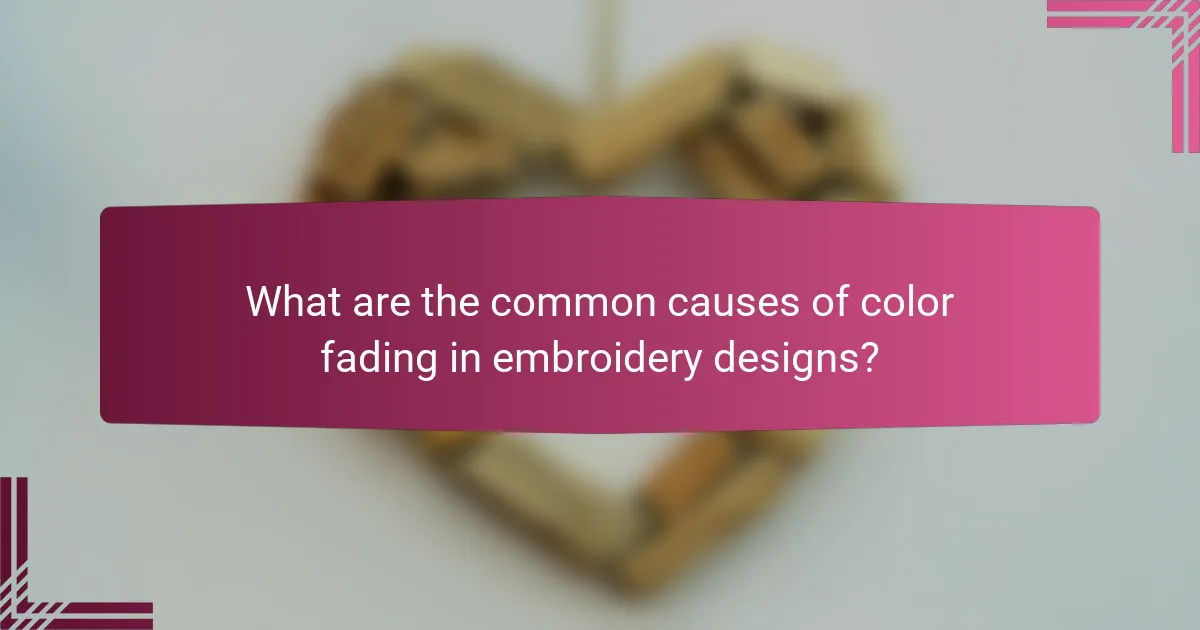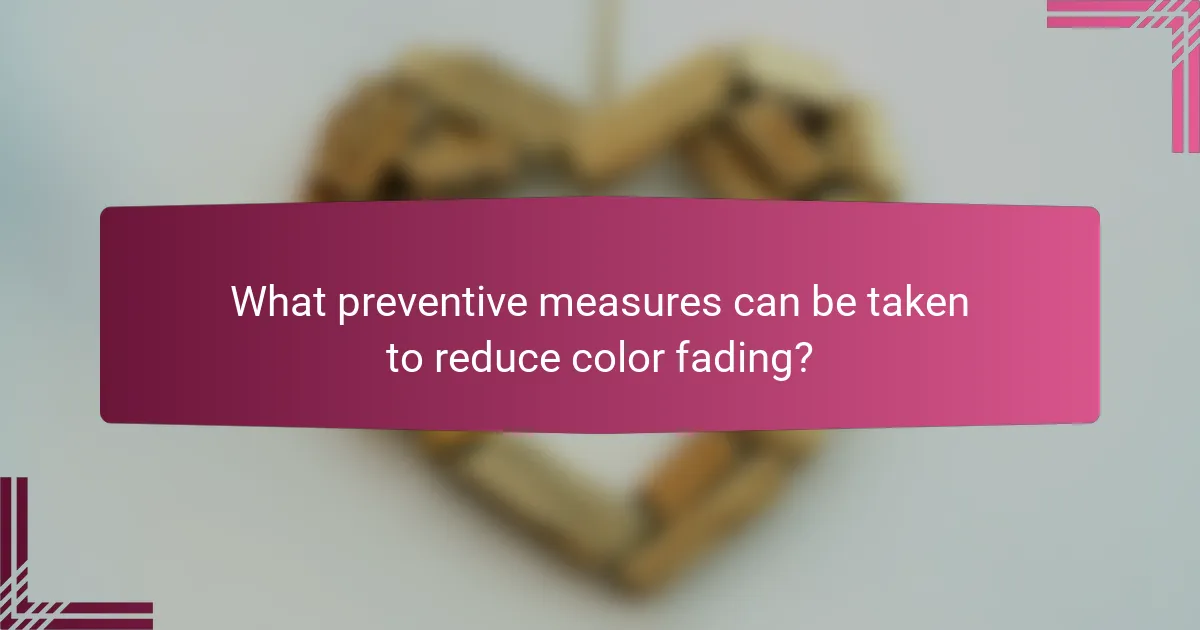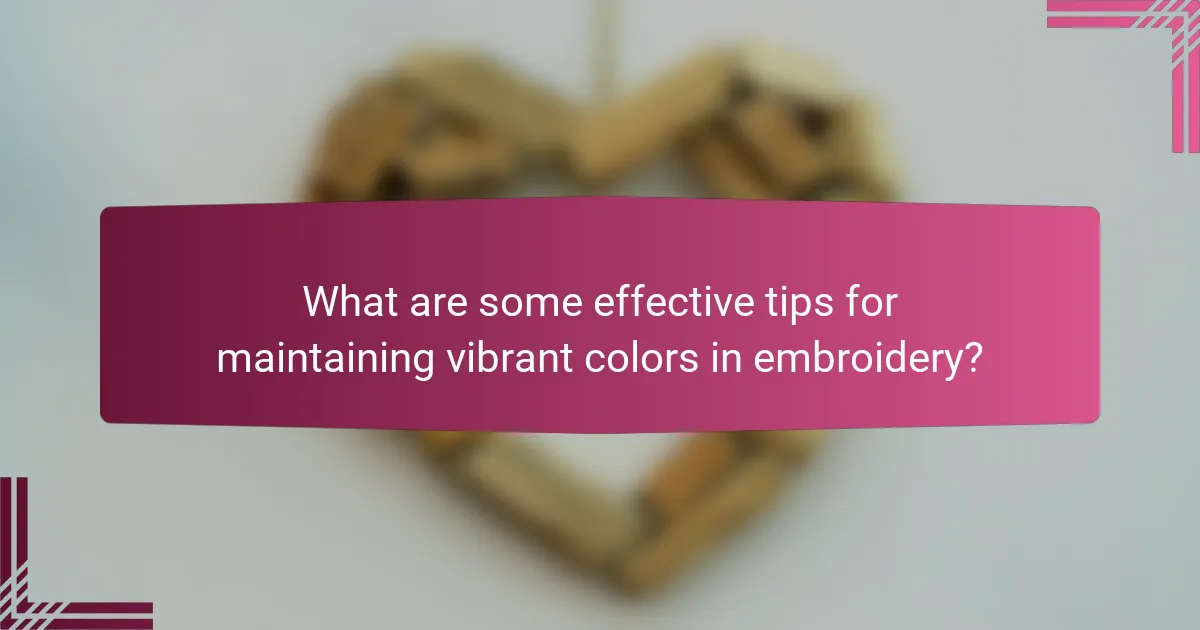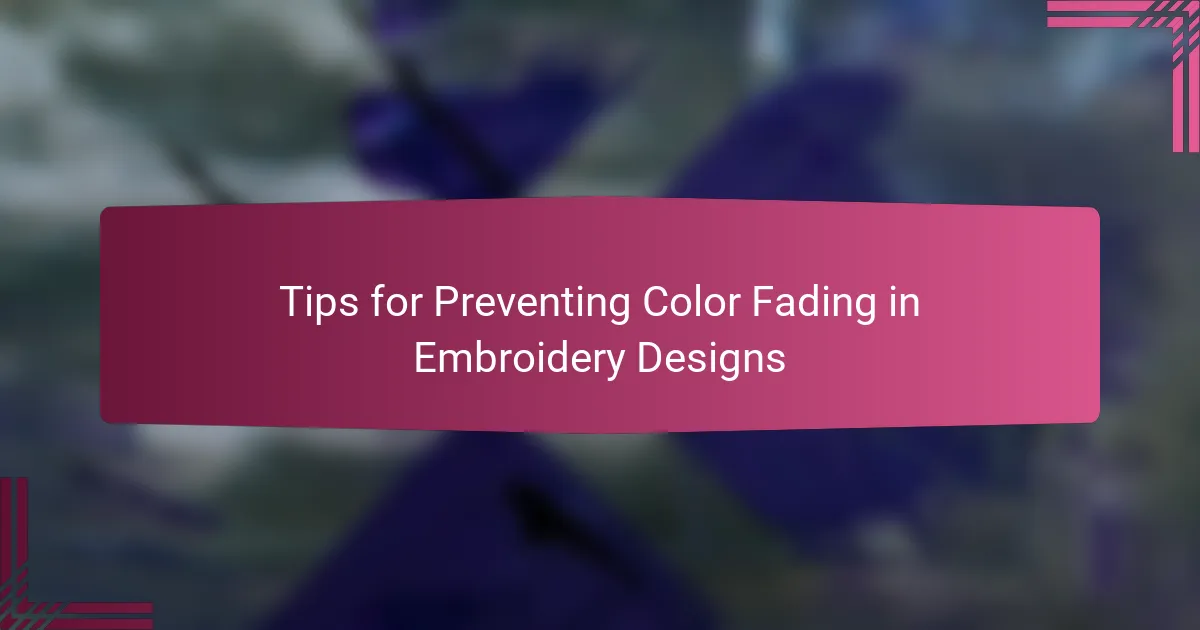
What are the common causes of color fading in embroidery designs?
Common causes of color fading in embroidery designs include exposure to sunlight, washing methods, and fabric type. Sunlight can break down dye molecules, leading to fading over time. Washing with harsh detergents or hot water can also degrade colors. Additionally, certain fabrics absorb dyes differently, affecting their longevity. Natural fibers tend to fade faster than synthetic ones due to their chemical structure. High humidity and temperature can accelerate the fading process as well. Proper care and storage can mitigate these effects.
How do different types of fabrics affect color retention?
Different types of fabrics significantly affect color retention. Natural fibers like cotton and linen tend to absorb dyes well, leading to vibrant colors. However, they may fade faster when exposed to sunlight and washing. Synthetic fabrics, such as polyester and nylon, generally hold colors longer due to their resistance to UV light and moisture. Research indicates that polyester retains color 30% better than cotton in similar conditions. Blends of natural and synthetic fibers can offer a balance of vibrancy and durability, enhancing overall color retention.
What fabrics are most prone to fading?
Fabrics most prone to fading include cotton, linen, and silk. These natural fibers tend to absorb dye deeply, but they also lose color quickly when exposed to sunlight. Synthetic fabrics like polyester are more resistant to fading. However, they can still fade, especially if not treated with UV protection. Research indicates that prolonged exposure to UV rays significantly accelerates fading in these materials. For instance, a study by the American Textile Manufacturers Institute found that cotton can lose up to 50% of its color after just a few months in direct sunlight.
How does fabric care influence color longevity?
Fabric care significantly influences color longevity by determining how well the dyes remain intact over time. Proper washing techniques, such as using cold water and mild detergents, prevent the fading of colors. Additionally, avoiding bleach and harsh chemicals helps maintain the vibrancy of the fabric. Drying methods also play a crucial role; air drying in the shade is preferable to machine drying in direct sunlight. The choice of storage conditions, such as keeping fabrics away from direct light and humidity, further protects color integrity. Research indicates that fabrics exposed to UV light can lose up to 50% of their color within a year. Therefore, consistent and careful fabric care is essential for preserving color longevity.
What role do embroidery threads play in color fading?
Embroidery threads significantly influence color fading in designs. The composition of the threads affects their resistance to fading. Natural fibers like cotton are more susceptible to fading than synthetic fibers such as polyester. Additionally, the dyeing process of the threads determines their colorfastness. Threads dyed with reactive dyes tend to fade less than those dyed with direct dyes. Environmental factors also play a role; exposure to sunlight accelerates fading in all thread types. Proper care, including washing and storage, can mitigate fading effects. Using high-quality threads is essential for preserving vibrant colors in embroidery.
Which types of threads are less likely to fade?
Synthetic threads, particularly polyester and nylon, are less likely to fade. These materials are designed to resist UV light and moisture, which contribute to fading. Polyester threads maintain color vibrancy even after multiple washes. They are often used in outdoor embroidery due to their durability. Cotton threads, while softer, tend to fade more quickly when exposed to sunlight. In contrast, synthetic threads offer superior color retention, making them a preferred choice for long-lasting embroidery.
How does thread quality impact color durability?
Thread quality significantly impacts color durability. Higher quality threads are made from better materials that resist fading. They often undergo superior dyeing processes that enhance color retention. For example, polyester threads typically maintain color longer than cotton threads. This is due to their resistance to UV light and moisture. Additionally, high-quality threads have tighter twists, which helps prevent fraying and color loss. In contrast, lower quality threads may bleed or fade quickly due to inferior dyes. Studies show that embroidery using premium thread can retain its vibrancy for years longer than those using subpar materials.

What preventive measures can be taken to reduce color fading?
To reduce color fading, use UV-resistant materials. These materials are designed to withstand sunlight exposure. Store embroidered items away from direct sunlight to minimize fading. Wash items in cold water to preserve colors. Avoid using bleach, as it can accelerate fading. Dry items in the shade instead of using a dryer. Use color-safe detergents that help maintain vibrancy. Regularly rotate items to prevent prolonged exposure to light. These practices can significantly extend the life of colors in embroidery designs.
How can proper washing techniques help maintain color?
Proper washing techniques help maintain color by reducing color fading during the laundry process. Washing garments in cold water prevents dye from bleeding. Using a gentle cycle minimizes agitation, which can cause colors to mix. Additionally, turning items inside out protects the outer surface from friction. Using mild detergents instead of harsh chemicals preserves the integrity of the dyes. Avoiding bleach is crucial, as it can strip color from fabrics. Finally, air drying instead of using a dryer prevents heat damage, which can fade colors. These practices collectively contribute to the longevity of vibrant colors in embroidered designs.
What are the best washing practices for embroidered items?
The best washing practices for embroidered items involve gentle handling and specific washing techniques. Hand washing is recommended to avoid agitation that can damage the embroidery. Use cold water and a mild detergent to protect the colors and fibers. If machine washing, place the item in a laundry bag to minimize friction. Always wash embroidered items inside out to shield the design. Avoid bleach and fabric softeners, as they can cause fading. Air drying is preferable; if using a dryer, select a low heat setting. Following these practices helps maintain the integrity of the embroidery and prevents color fading.
How does water temperature affect color fading?
Water temperature significantly affects color fading in fabrics. Higher water temperatures can accelerate the fading process of dyes. This is due to the increased solubility of dye molecules at elevated temperatures. As temperatures rise, the bonds between dye and fabric weaken. Consequently, more dye is released into the water. Studies show that washing at 60°C can lead to a 30% greater color loss compared to 30°C. Lower temperatures help preserve the integrity of the dye. Thus, washing embroidery designs in cooler water is recommended to minimize color fading.
What storage methods can protect embroidered designs from fading?
To protect embroidered designs from fading, store them in a cool, dark place. Light exposure contributes significantly to color fading. Use acid-free tissue paper to separate layers of embroidery. This prevents friction and potential damage. Keep embroidered items in breathable fabric bags. Plastic can trap moisture, leading to mildew. Avoid folding embroidered designs; roll them instead to maintain shape. Store them flat when possible to prevent creasing. These methods help preserve the vibrancy of colors over time.
How should embroidered items be stored to prevent exposure to light?
Embroidered items should be stored in a dark, cool place to prevent exposure to light. Use opaque storage containers or boxes that block light. Avoid transparent materials that allow sunlight to penetrate. Wrapping items in acid-free tissue paper also provides protection from light. Hanging embroidered items can expose them to light; therefore, fold them instead. Regularly check the storage area for light leaks. Keeping humidity low helps maintain color integrity as well. Following these steps helps preserve the vibrancy of embroidery designs.
What containers are best for preserving color integrity?
Opaque containers are best for preserving color integrity. They block light exposure, which can cause fading. Glass or dark plastic containers are effective choices. These materials prevent UV light from degrading colors. Airtight seals also help by minimizing moisture and air exposure. Reduced humidity prevents color bleeding and fading. Storing items in a cool, dry place further enhances preservation. Research indicates that light and humidity are primary factors in color degradation. Therefore, using the right containers significantly extends the vibrancy of embroidery designs.

What are some effective tips for maintaining vibrant colors in embroidery?
To maintain vibrant colors in embroidery, use high-quality threads and fabrics. Quality materials resist fading and ensure color longevity. Always wash embroidered items in cold water. Cold water helps preserve the integrity of the colors. Avoid direct sunlight exposure when storing or displaying embroidered pieces. Sunlight can significantly fade colors over time. Use a gentle detergent specifically designed for delicate fabrics. This helps maintain the vibrancy without damaging the threads. Iron embroidered items on the reverse side at a low temperature. This prevents direct heat on the colors, preserving their brightness. Regularly check for signs of fading and address them promptly. Early intervention can help restore vibrancy before it worsens.
How can regular maintenance enhance the longevity of colors?
Regular maintenance can significantly enhance the longevity of colors in embroidery designs. Consistent cleaning prevents dirt and grime buildup that can dull colors. Using appropriate detergents preserves the vibrancy of threads. Regularly checking for loose threads prevents further unraveling and fading. Proper storage away from direct sunlight reduces exposure to harmful UV rays. Maintaining optimal humidity levels prevents color distortion from moisture. Following manufacturer care instructions ensures that colors remain intact over time. Studies show that textiles maintained properly can retain their original colors for years longer than those that are neglected.
What cleaning products should be avoided to prevent fading?
Bleach and ammonia-based cleaners should be avoided to prevent fading in embroidery designs. These products contain harsh chemicals that can strip color from fabrics. Additionally, products with high alcohol content can also lead to discoloration. Using abrasive cleaners can damage the fabric’s surface, causing further fading. Opt for gentle, color-safe detergents instead. These alternatives help maintain the vibrancy of the embroidery colors.
How often should embroidered items be cleaned to maintain color?
Embroidered items should be cleaned every 3 to 6 months to maintain color. Regular cleaning prevents dirt and oils from embedding in the fabric. Washing too frequently can cause fading. Using gentle detergents helps preserve the vibrancy of the colors. Air drying is recommended to avoid heat damage from dryers. Following these guidelines can extend the life of the embroidery.
What best practices should be followed for displaying embroidered designs?
To display embroidered designs effectively, use proper lighting to enhance visibility. Avoid direct sunlight, as it can cause color fading. Choose a neutral background that contrasts with the embroidery for better emphasis. Frame the designs to protect them from dust and physical damage. Regularly clean the display area to maintain appearance. Use acid-free materials to prevent degradation over time. Position the display at eye level for optimal viewing. These practices help preserve the quality and vibrancy of embroidered designs.
How can framing and mounting techniques prevent color loss?
Framing and mounting techniques can prevent color loss by providing protection from environmental factors. Proper framing blocks UV rays, which can fade colors over time. Using acid-free materials prevents chemical reactions that may degrade fabric dyes. Additionally, mounting techniques that minimize contact with the fabric reduce wear and tear. Sealing the edges of the fabric can also protect against dust and moisture. These methods ensure that the colors remain vibrant for longer periods. Research indicates that UV-filtering glass can reduce fading by up to 98%.
What lighting considerations should be taken into account to protect colors?
To protect colors in embroidery designs, use natural light or soft white LED lighting. Harsh lighting can cause colors to fade over time. Natural light is ideal as it shows true color without distortion. Soft white LEDs minimize the risk of fading compared to cool white or daylight LEDs. Avoid direct sunlight exposure which can lead to significant color degradation. Use UV-filtering window treatments to reduce harmful rays indoors. These considerations help maintain the vibrancy and longevity of colors in embroidery.
What troubleshooting tips can help address fading issues in embroidery?
To address fading issues in embroidery, check the thread quality first. High-quality threads are less prone to fading. Ensure the correct needle type is used for the fabric. A mismatched needle can cause uneven stitching, leading to color loss. Verify the washing instructions for the fabric and thread. Washing in hot water can accelerate fading. Use mild detergents to preserve color integrity. Store embroidered items away from direct sunlight. Prolonged exposure to sunlight can cause colors to fade quickly. Lastly, consider using fabric protectants. These products can provide an additional layer of defense against fading.
The main entity of this article is color fading in embroidery designs. It examines common causes of fading, such as sunlight exposure, washing methods, and fabric types, highlighting how natural fibers fade faster than synthetics. The article also discusses the impact of fabric care and thread quality on color longevity, offering preventive measures to reduce fading, including proper washing techniques and storage methods. Additionally, it provides tips for maintaining vibrant colors through regular maintenance and best practices for displaying embroidered designs.
